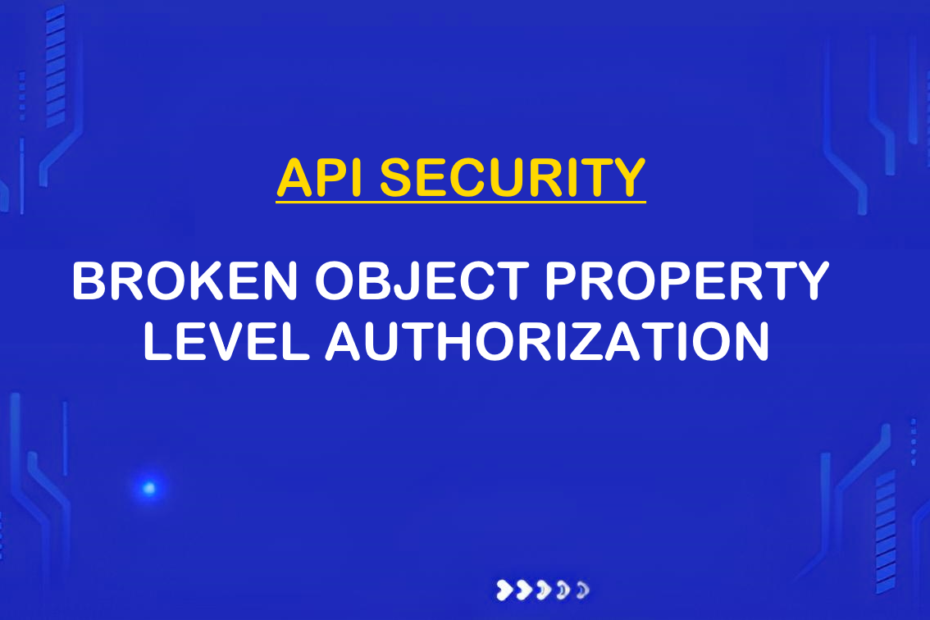Introduction:
API security is crucial for protecting sensitive data and preventing unauthorized access. In 2023, API3 faced a major security vulnerability known as “Broken Object Property Level Authorization” (BOLA). This blog post will guide us through the process of testing, exploiting, and mitigating this vulnerability using popular tools like Postman and Burp Suite.

Understanding “API3: 2023 Broken Object Property Level Authorization”:
Broken Object Property Level Authorization (BOLA) refers to a vulnerability where an API fails to enforce proper authorization at the object or property level. It allows attackers to gain unauthorized access, modify data, or perform actions beyond their intended permissions.
Testing the Vulnerability with Postman:
To test the BOLA vulnerability in API3, we’ll use Postman, a popular API testing tool. Follow these steps:
Step 1: Authenticate:
Authenticate with API3 using Postman, obtaining a valid access token or API key.
Step 2: Enumerate Endpoints:
Explore the API3 endpoints related to the functionality affected by the BOLA vulnerability. Identify endpoints that allow manipulation of object properties or access to other users’ resources.
Step 3: Test Unauthorized Access:
Send a request to retrieve an object belonging to another user without proper authorization. For example, if the API allows accessing user profiles, attempt to retrieve another user’s profile by manipulating the request parameters or headers.
Step 4: Test Property Modification:
Send a request to modify an object property that should be restricted. For instance, if the API allows updating user profile data, try changing properties such as email, username, or password for another user.
Step 5: Observe Results:
An API3 instance affected by the BOLA vulnerability will likely allow unauthorized access or improper modification of object properties. Observe the responses received and note any discrepancies indicating the vulnerability.
Exploiting the Vulnerability with Burp Suite:
To exploit the BOLA vulnerability in API3, we’ll use Burp Suite, a comprehensive web application security testing tool. Follow these steps:
Step 1: Configure Burp Suite:
Set up Burp Suite as an intercepting proxy, capturing requests and responses between your browser and the API.
Step 2: Intercept the Request:
Use Burp Suite to intercept a request to the API endpoint that exhibits the BOLA vulnerability. Modify the request parameters, headers, or any relevant data to attempt unauthorized access or property modification.
Step 3: Modify and Forward the Request:
Manipulate the intercepted request to gain access to another user’s resources or modify their object properties. For example, change the user ID or object ID in the request payload to access or manipulate unauthorized data.
Step 4: Observe the Response:
Examine the response obtained after forwarding the modified request. If the API3 instance is vulnerable to BOLA, you’ll observe that the response allows unauthorized access or reflects the modified object properties.
Consider an e-commerce platform that utilizes the API3 framework to manage its backend API endpoints. The platform allows customers to manage their product listings, including modifying the prices and descriptions of their listed items.
In this scenario, the API has a flaw in its authorization mechanism, specifically related to object property level checks. Let’s assume that a customer with a valid authentication token wants to modify the price of their product with the following details:
Product ID: 12345 Name: “Smartphone” Price: $500
Normally, the API should only allow the authenticated customer to modify their own product’s price. However, due to the Broken Object Property Level Authorization vulnerability, the API fails to enforce proper authorization at the property level.
An attacker with malicious intent, who is also an authenticated customer, can exploit this vulnerability to modify the price of another customer’s product. Let’s say the attacker wants to reduce the price of a competitor’s product with the following details:
Product ID: 67890 Name: “Laptop” Price: $1000
Using a tool like Postman, the attacker sends a request to the API endpoint responsible for updating the product’s price. They modify the request payload to include the competitor’s product ID and set a significantly lower price, like $100.
Normally, the API should reject this request because the attacker doesn’t have the necessary authorization to modify the competitor’s product. However, due to the BOLA vulnerability, the API allows the request and updates the competitor’s product price to $100.
As a result, the attacker successfully manipulated the API endpoint, bypassing proper authorization checks, and modified the property (price) of another customer’s product. This unauthorized action can have severe consequences, such as unfair competition, financial loss for the affected customer, and damage to the platform’s reputation.
Mitigating the BOLA Vulnerability:
Once the vulnerability is confirmed, it’s crucial to mitigate the issue to ensure the security of API3. Here are some mitigation strategies:
-
Implement Proper Authorization Checks:
Review the authorization mechanisms and ensure that access controls are enforced at the object or property level.
-
Perform Input Validation and Sanitization:
Validate and sanitize all user input to prevent injection attacks and enforce data integrity.
-
Adopt Role-Based Access Controls (RBAC):
Implement RBAC to assign granular permissions to different user roles, limiting their access to sensitive resources.
-
Regular Security Audits and Penetration Testing:
Conduct routine security audits and penetration testing to identify vulnerabilities and address them promptly.
-
Educate Developers and Security Teams:
Train developers and security teams on secure coding practices, emphasizing the importance of authorization and access control.
Conclusion:
Testing, exploiting, and mitigating the “API3: 2023 Broken Object Property Level Authorization” vulnerability is crucial to ensure the security of API endpoints. By using tools like Postman and Burp Suite, we can identify vulnerabilities, simulate potential attacks, and take steps to mitigate the risks.
Citations:
API3:2023 Broken Object Property Level Authorization – OWASP API Security Top 10
For further clarifications or support, please write to contact@paradigmitcyber.com
